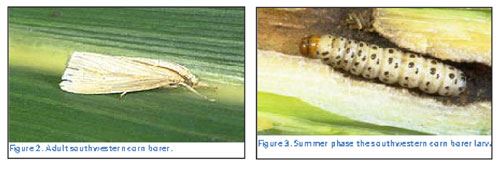Southwestern Corn Borer Flights On The Rise
PRINCETON, KY.
Adult flight of southwestern
corn borer (SWCB) is
on the rise and has
many producers asking questions.
This insect can be
problematic in Kentucky’s
major corn growing region, is
more problematic in the western
half of the state and is
particularly important in the Purchase Area.
The UK-IPM program runs pheromone baited
traps to monitor this pest in Lexington and
Princeton, KY experiment farms and cooperates
with Mr. Cam Kenimer, the Agriculture and Natural
Resources agent in Fulton County, who
monitors SWCB traps in his county. See:
http://www.uky.edu/Ag/IPMPrinceton/counts/swc b/swcbgraph.htm and
http://ces.ca.uky.edu/fulton/InsectTraps
Current Flight Status: This pest is rare in the
eastern half of the state and no moths have
been captured in the Lexington trap this year.
In Princeton, moths are being captured and
these captures are increasingly greater than the
rolling five-year average. Thus far, the Fulton
county trap has captured the largest numbers
and, like Princeton, the captures are increasing
(at this writing 75 moths per week).
This increase in captures has alarmed some
individuals. Nevertheless, the capture rates
thus far are nowhere near as large as the historic
captures of the previous decade. See:
http://www.uky.edu/Ag/IPM/trapdata/trapdata.
htm Before the widespread use of corn
products containing “B.t. corn borer traits”, the
peak weekly captures were much greater. Consider
the current 75 moths per week in light of
the historic five- year average peak for 1999-
2003 which exceeded 350 moths per week. In
some years peak captures were in excess of 800
moths per week and it was not unknown to capture
more than 1000 moths per week!

With a few local exceptions it is unlikely that
there will be widespread damage to corn from
this pest. Nonetheless, infestation rates in a
specific field cannot be predicted by captures in
distant traps. One must scout those fields to
know the pest level. Field corn products which
contain “corn borer B.t. traits” will be largely
protected from this pest. However, field corn
refuges, sweet, pop and other food grade corns
that do not contain “corn borer B.t traits”
should be scouted for the presence of this pest.
One should scout for SWCB from June
through August. There are at least two and possibly
three generations per season. Monitor
fields in June for “shot hole” feeding to whorl
leaves. If damage is noted while walking
through the field, examine 20 consecutive
plants for each of several locations and record
the number of plants that are damaged.
If “shot hole” damage is recorded for 35 percent
of the plants sampled, an insecticidal control
is warranted. This is the most important
time to treat as the second generation is very
difficult to detect and control. If insecticidal control
is warranted, you may find a list of approved
products in ENT-16, Insecticide
Recommendations for Corn. This publication is
available from your County Extension office or
on the web at: http://pest.ca.uky. edu/ EXT/Recs/welcomerecs. html
Remember it is not the moths (Figure 2.) but
rather the larvae aka caterpillars or worms (Figure
3.) that cause the destruction. Spraying
when moth flight peaks is not really doing you
any good. You need to wait until the larvae
begin to appear. Using May 31 as a starting
point (the peak of the current moth flight) a 50oF
degree day model predicts that SWCB caterpillars
should be showing up just abut now!
In addition, you must treat while the larvae
are still active in the whorl. Once they are in the
stalk, foliar application will not provide control.
For more information on the southwestern corn
borer see: Entfact-108.asp, Southwestern Corn
Borer, available at your county extension office
or on line at: http://www.ca.uky.edu/entomology/entfacts/ef108.asp . Δ
DR. DOUG JOHNSON: Extension Professor of
Entomology and IPM Coordinator, University of
Kentucky